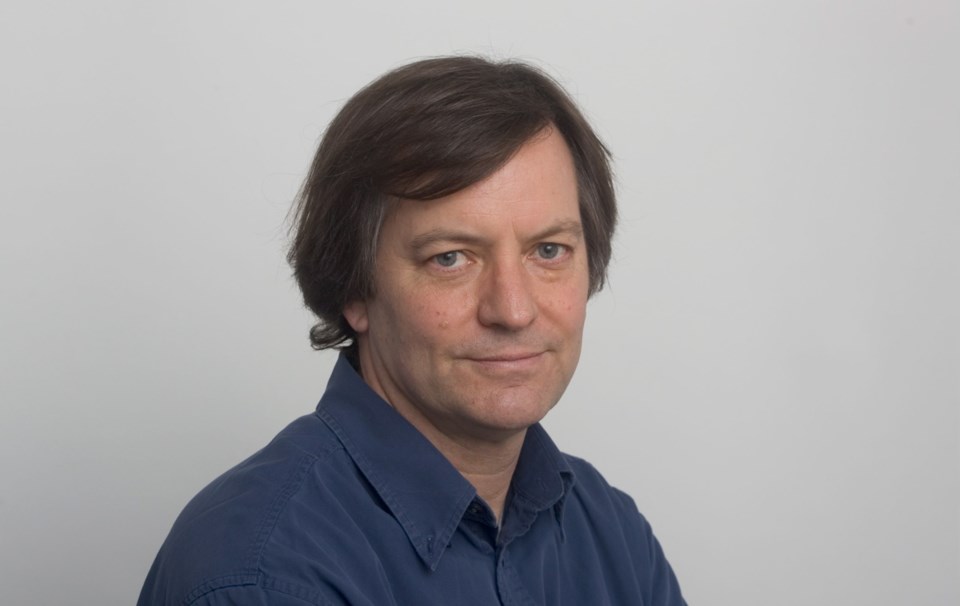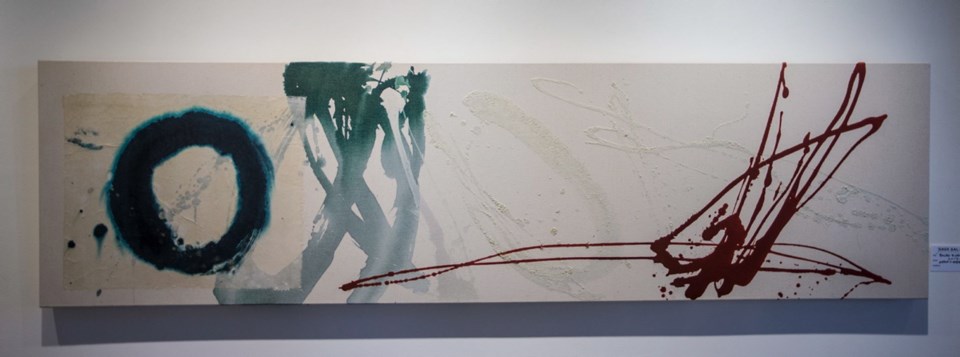Cusp: Mixed Media Paintings by Heather Midori Yamada at Gage Gallery, 2031 Oak Bay Ave., until Oct. 28.
 Heather Midori Yamada paints on paper and canvas in an abstract mode. Subtle colours and free-swinging brush strokes dance across open spaces, inhabiting an organic universe all their own. Each of the layers of her painting activity seems to interact in a harmonious way, and this mirrors the integration of the various phases of her life and activities.
Heather Midori Yamada paints on paper and canvas in an abstract mode. Subtle colours and free-swinging brush strokes dance across open spaces, inhabiting an organic universe all their own. Each of the layers of her painting activity seems to interact in a harmonious way, and this mirrors the integration of the various phases of her life and activities.
Yamada has been making a slow move to Victoria over the past two years, and still maintains strong connections to Toronto and Montreal, where she exhibits her art and teaches painting, meditation and yoga — sometimes all three together.
The child of second-generation Japanese-Canadian parents, Yamada had a suburban Canadian childhood in Toronto.
“Toronto was really square,” she admitted. She read about Zen Buddhism when she was 12 years old, but put it aside to pursue typical Canadian dreams.
After high school in the 1970s, she enrolled at the University of Western Ontario and graduated from a three-year course in fine art.
Her next five years were occupied with the typical drop-out-and-go-to-Europe period, and then she took a fourth year in fine art at Toronto’s York University.
Not many of her teachers left a lasting impression, but at York she was inspired by Ron Bloore, whose white-on-white abstract paintings were gaining national renown.
“As a human being, this guy was impeccable,” she told me. “Really tough, but kind.”
She was producing abstract canvases three metres across, but after a year at York she confronted a world where there was really no chance of a career as an artist.
“I was a complete misfit,” she said. “I had horrible jobs, and I was never going to fit into any of that.”
Armed with her university degree, and much to her mother’s dismay, Yamada went to work as a server, a role she filled for the next 25 years.
With three shifts a week, she could “meagerly” support herself — no house, no car, no kids.
But for the other four days, she pursued her art without worrying about selling it. Her paintings at the time were muddy and murky, with tints of mustard and sepia and black.
“That was what was happening on an interior level,” Yamada acknowledged.
During that time, she also worked at Open Studio, a printmaking atelier in Toronto. There she discovered washi, the handmade Japanese paper made of organic fibres, which absorbs ink and colours, so different from the surfaces of western materials. Eventually, she left the toxic processes of etching and lithography behind and began painting on washi.
In the years since, Yamada has also cultivated flower arranging and Buddhist studies. These interests provide a basis for her popular painting workshops, and allow her to cultivate her studio practice.
Inspired by natural phenomena, she pours and brushes colours and ink onto paper and canvas.
“I work with a lot with happy accidents,” she said.
The paper inspires her.
“The more you work on it, it does stuff for you. You just have to get out of the way.”
She doesn’t set out to “make art.” Rather, she follows her instincts, and the art work is a natural outcome.
“I may begin with certain ideas in my mind,” Yamada said, “but the moment I put my hand on it, all the ideas disappear. If it try to force it, the painting does not work.”
With her large paintings, she begins by laying down a few layers of wash. Tinting and preparing papers is done at another time.
Eventually, all the pieces come together as a collage, and further gestures are added as a satisfying universe of creativity unfolds. Inevitably, this is a slow process.
“I will work on something, and if I can’t resolve it, I will leave it — for decades,” she said. “It might look spontaneous, but it is coming from something … and it’s a lot of something.”
The marks she makes seem to hang in space, cycling into view from somewhere much bigger than the surface they are inscribed upon.
Each of the brush strokes has an inherent form.
While they look as if they all arrived in an instant, the components actually took a long time to assemble, one bit at a time. This duration results in the tremendous sense of space that opens up in her work.
This notion of empty space is crucial to the compositions.
“The sparser the piece, the more it works,” the artist said.
Beginning in the middle of November, Yamada will present a workshop at her Johnson Street studio and she explained her approach to me.
“I teach and transmit my love and knowledge of Japanese paper to other people. I can take people who have never lifted a brush, and take them to a place where they can express some sort of inner feeling.”
There are other aspects to Yamada’s practice. As well as the abstract fields presented in this show, she loves to paint flowers in a free-flowing manner with watercolours.
And at the moment she has a show in Toronto at the Japanese Canadian Cultural Centre with sculptor Warren Hayano, under the title Look for Banners to Rise. There, her large, colour-infused sheets of washi hang from the ceiling.
Here in Victoria, the smaller works provide a good introduction to this artist’s work.
• Heather Midori Yamada can be contacted at artyamada.com.



